Trams in Amsterdam
The Amsterdam Tram (Dutch: Amsterdamse tram) is a tram network in Amsterdam, Netherlands. It dates back to 1875 and since 1943 has been operated by municipal public transport operator Gemeentelijk Vervoerbedrijf (GVB), which also runs the Amsterdam Metro and the city bus and ferry services. Amsterdam has the largest tram network in the Netherlands and one of the largest in Europe.
| Amsterdam Tram | ||||||||||||||||||||||||||||||
|---|---|---|---|---|---|---|---|---|---|---|---|---|---|---|---|---|---|---|---|---|---|---|---|---|---|---|---|---|---|---|
 | ||||||||||||||||||||||||||||||
.jpg.webp) | ||||||||||||||||||||||||||||||
| Operation | ||||||||||||||||||||||||||||||
| Locale | Amsterdam, Netherlands | |||||||||||||||||||||||||||||
| ||||||||||||||||||||||||||||||
| ||||||||||||||||||||||||||||||
| ||||||||||||||||||||||||||||||
Network overview
As of 2020, the tram network consisted of 14 lines operating over 95 kilometres (59 mi) of routes and 200 kilometres (120 mi) of standard gauge track with 650 switches and 500 tram stops. Every year, the tram fleet travels almost 12 million kilometres (7.5 million mi) while in service. Tram service consumes 45 million kilowatts of electicity per year, all produced from green sources.[2][1]
The fleet consists of about 200 trams, of which 155 are Combinos (types 13G and 14G) from Siemens. Older trams, types 11G en 12G built by La Brugeoise et Nivelles, operate on lines 5, 19 and 24. The latest trams that GVB has received are type 15G trams from Construcciones y Auxiliar de Ferrocarriles which run on line 25. Trams of types 11G, 14G and 15G are bi-directional for use on lines 5 and 25 which have terminals without turning loops.[2] All other tram lines have turning loops and use unidirectional trams.[2] Lines 25 (Amsteltram) and 26 (IJtram) can operate trams coupled in pairs; both lines run in a right-of-way mostly separated from road traffic.[4][5]
The tram network serves all boroughs in Amsterdam except for Amsterdam-Noord on the north side of the IJ.[2] Tram lines 5 and 25 extend south of the borough of Amsterdam-Zuid to serve the municipality of Amstelveen,[6] and tram line 19 extends east of the borough of Amsterdam-Oost to serve the municipality of Diemen.[7]
History
Beginnings

On 3 June 1875, Amsterdam's first horse-drawn tramway was opened. It linked Plantage with the Leidseplein, and was operated by AOM (Amsterdamsche Omnibus Maatschappij), which had been founded in 1872 by Karel Herman Schadd, amongst others.
In the last quarter of the 19th century, horse trams ran through the main streets of Amsterdam, linking all neighborhoods inside the Singel with Dam Square, and were extended to newly constructed residential areas. By the end of the century, about 15 lines led to or from the Vondelstraat, Overtoom, Willemsparkweg, Amsteldijk, Linnaeusstraat, Weesperzijde, Bilderdijkstraat and Ceintuurbaan.
The lines of the original horse tram lines can still clearly be recognised in the present day tram routes 1, 2, 3, 4, 7, (9, 10) and 13.
Gemeentetram
As of 1 January 1900, the municipality of Amsterdam took over AOM. The company continued as the Gemeentetram Amsterdam (GTA). A total of 242 tramcars, 758 horses and 15 buildings were acquired along with the company.
Between 1900 and 1906, all but one of the existing tram lines were electrified. Additionally, the AOM's unusual track gauge of 1,422 mm (4 ft 8 in) was converted to 1,435 mm (4 ft 8 1⁄2 in) standard gauge.
By 1906, the electric tram network consisted of 12 tram lines (1-11 and 13). To operate these lines, the GTA purchased 229 new electric tramcars. The former horse-drawn trams were progressively reclassified as tram trailers. In 1906, the Amsterdamse Tramharmonie orchestra (now known as Symfonisch Blaasorkest ATH) was founded. This orchestra, composed of amateur musicians from the Amsterdam region, still exists.
The last remaining Amsterdam horse tramway was line 12 (Nassauplein–Sloterdijk), which was electrified in 1916. Five years later, upon Amsterdam's annexation of the municipality of Sloten, a former Sloten horse tramway came under the control of the GTA. The horses of this line, which linked Overtoom with Sloten, were replaced by tram-hauling buses in 1922; the line was converted into a conventional bus line in 1925.
Further developments

.jpg.webp)


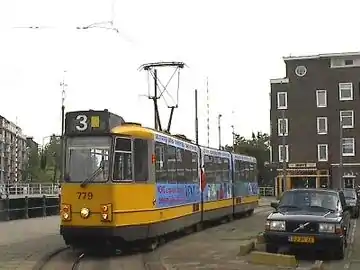
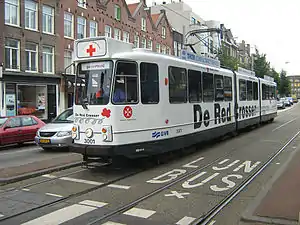


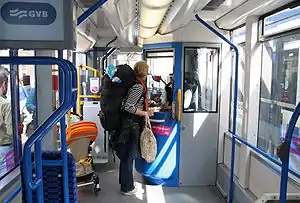

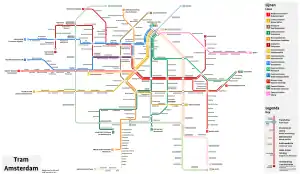
Between 1910 and 1930, the growth of the city generated many new extensions to the tram lines. The first thirteen electrified tram lines were joined by: line 14 in 1910, lines 15–18 in 1913, line 19 in 1916, lines 22 and 23 in 1921, line 20 in 1922, line 21 in 1928, line 24 in 1929 and line 25 in 1930.
In 1931, the tramway network reached its greatest extent, at 25 tram lines. From that year to 1940, (almost) all the districts in the city could be reached by tram. Between 1900 and 1930, the fleet grew to 445 motorised trams and approximately 350 trailers. These were all twin axle vehicles with wooden bodies.
From 1922 until 1971, all trams had mailboxes at their rear side. These were emptied at Centraal Station; the post office's distribution centre was located next to the station, at Stationsplein, and later at Oosterdokskade. Thanks to the tram mailboxes, a letter could be delivered on time, even if it is too late for the last collection from the regular mailboxes.
During the Great Depression of the 1930s, the tram service was reduced. In 1932, lines 12, 15, 19, 20 and 21 were abandoned. However, as part of the Eastern Railway Works (Spoorwegwerken Oost) in 1939-1942, trams came to the new neighborhoods in Amsterdam-Oost, to serve the Watergraafsmeer, the new Amstel station and the rebuilt Muiderpoort station.
On 1 January 1943, the GTA merged with the Gemeenteveren to form Gemeentelijk Vervoerbedrijf (GVB).
Between 1940 and 1945, the trams carried big crowds and faced a crisis. Several lines had to be suspended (lines 4, 6, 8 and 14), before the whole service ceased in October 1944 due to a coal shortage. Many tram cars were transported eastward.
Postwar period
Following the end of World War II, tram services were resumed in June 1945, initially with only limited service (lines 1, 3, 5, 7, 9, 10, 12, 13, 16, 24, 25). Line 5 was split into line 5 and line 12. Some lines were returned to service in later years: lines 2, 17 and 18 (in 1947) and 4 (in 1948). Between 1945 and 1949, the emergency line 26 was the tram line with the highest line number, followed by line 11. In 1948 and 1949, a special tram S ran as an express service from line 25 to Amstel station.
Tram lines 6 and 23 did not return to regular service, but operated intermittently until 1958 for transportation to the stadium. Lines 8, 14 and 22, used during the war, were not reactivated as tram lines, although line 22 was revived in 1950 as a bus line.
Between 1948 and 1950, the GVB acquired sixty motorised trams and fifty trailers, known as the three axles (drieassers). They were built by Werkspoor in Utrecht-Zuilen, and replaced the then oldest trams in the fleet, which had entered service in 1902.
After a period of reconstruction in the 1940s, one tram line after another was shut down in the 1950s. Buses were considered to be more practical. Thus, between 1950 and 1965 lines 18, 12, 11, 17 and 5 (provisionally in 1961, finally in 1965) were replaced, in that order, by bus services. Only the Leidsestraat and Utrechtsestraat remained served by tram lines (lines 1, 2 and 4), which were necessary because these streets were too narrow for buses.
Revival
In the mid-1950s, (modern) tramcars came back into the spotlight. The 25 articulated trams ordered in 1955 to serve only the Leidsestraat lines 1 and 2 were well received, and secured the future of trams in Amsterdam. Between 1957 and 1968, 160 new articulated vehicles, manufactured by Beijnes and Werkspoor in the Netherlands, were added to the fleet; they were numbered 551-587 and 602-724. The old twin axle trams from the prewar period were withdrawn from service between 1945 and 1968.
Extensions
After the trams had returned to favour in the inner city, the newly created Western Garden Cities (Westelijke Tuinsteden) in the west of Amsterdam were connected with its tramway network: Bos en Lommerplein in 1950, Slotermeer in 1954, and Osdorp in 1962.
There were also some other new tram lines with line numbers that had long since disappeared or had never existed. Line 17, which was closed in 1956, was revived in 1962 (to Osdorp), when line 27 appeared on the old route of line 17. In October 1971, line 1 was extended to Osdorp. Line 27 disappeared in 1971. In 1977, upon the opening of Amsterdam's first metro line, lines 6 and 12 appeared. In 1978, with the opening of Station Zuid), came line 5, and in 1982, a new line 14 (to Station Sloterdijk) was opened, forty years after the lifting of the original line 14.
Other changes also occurred. In 1971, the tramway postal service was abandoned. In 1972-1973, the first group of articulated trams were extended by the addition of a middle section, to become bi-articulated trams. Also in the early 1970s, two series of new trams were ordered from Linke-Hofmann-Busch in Salzgitter, Germany, to operate the new western extensions. In 1974-1975, nos 725-779 entered the fleet, and in 1979-1981, nos 780-816 joined them.
By the early 1980s, the GVB had 252 bi-articulated trams available for use, at that time the highest number in any city in Europe. In 1983, after only 35 years - a short time for the Amsterdam tramway network - the three axle trams operated their last services; they had never been liked by the tram personnel. Between 1981 and 1983, the GVB also lost four other trams, when they were destroyed by fires started by rioting squatters.
Meanwhile, further western extensions of the network were opened, to Geuzenveld in 1974, Slotervaart-Zuid in 1975, Nieuw Sloten in 1991 and De Aker in 2001. Other enhancements were to: Station Zuid in 1978, Flevopark in 1980, Station RAI in 1981, Station Sloterdijk in 1982 (extended in 1985), and a second connection with Bos en Lommer/Slotermeer in 1989.
In 1985, a tram line was built to Haarlemmerhouttuinen, but not connected to other tracks, nor equipped with overhead wires. Thirty years later, it had still not entered into service.
New technology
In 1989-1991, to replace the oldest articulated trams, and to operate new lines, 45 articulated vehicles (numbers 817-841 and 901-920) were built by BN in Bruges, Belgium. They were Amsterdam's first (partly) low-floor trams. During the same period came the first withdrawals of the first articulated trams from 1957, apart from a few vehicles that had previously had been damaged by fire or a collision. Additionally, a number of the 1974-1975 LHB vehicles were removed from service.
In 1990, a new tramway to Buitenveldert and Amstelveen was ready to go. Line 5 links Station Zuid with Amstelveen Binnenhof, while line 51 ran as a light rail service, from Station Zuid to Amstelveen Poortwachter, and later to Westwijk in 2004. Also in 1990, line 9 to the Watergraafsmeer was extended to Diemen (Sniep). In 1991, a rush hour line 20 and a special events line 11 were opened. In 1993 a support line 11 and in 1997 a circle line 20 were added to the network. Lines 6, 11 (2 lines) and 20 have since disappeared. However, line 11 is still used occasionally for extra services to the RAI convention centre.
Between 2002 and 2004, following an order for 155 Siemens Combino trams (nos 2001-2151 and 2201-2204), the existing tram fleet was largely renewed. Four of the Combinos were specified as bidirectional vehicles, for use on line 5 to Amstelveen. By mid-2004, 155 Combinos had been delivered. As a result, the last old articulated cars of the 1960s were removed from service in March 2004. However, between 2004 and 2008 all of the Combinos had to be taken progressively out of service for repairs and strengthening, to correct their many structural faults.
Changes 2001—2016
In December 2001, line 1 was extended to the new district of De Aker, and line 17 replaced line 1 on the route between Osdorpplein and Dijkgraafplein. For a lengthy period, line 24 was diverted via line 16, and line via line 4, during the construction of the De Pijp metro station on Ferdinand Bolstraat. In December 2002, line 6 was diverted to call at Centraal Station in place of Stadionplein, and in November 2003, line 16 was extended from Stadionplein to the VU Medisch Centrum.
In May 2004, line 10 was extended/diverted to Java-eiland (Azartplein). Lines 7 and 14 was later rerouted to Amsterdam-Oost (with a terminus at Flevopark). In December 2004, line 6 started sharing a terminus with line 16 at VU Medisch Centrum (Gustav Mahlerlaan). Since that month, line 7 has been sharing the Sloterpark terminus of line 14; the former line's terminus had earlier moved to Surinameplein, because the turning loop at Bos and Lommerplein had been closed.
On 30 May 2005, a new line, the IJ-tram (line 26) was opened (Centraal Station – Piet Heintunnel – IJburg, a distance of 8.5 km (5.3 mi)) and (initially) line 16 was extended from CS to the Passagiersterminal (for cruise ships). Twelve months later, line 6 was closed, and the route CS–Passagiersterminal was taken over by line 25 from line 16 (it was later curtailed again to CS). In December 2006, line 24 was extended from Olympiaweg to VU Medisch Centrum.
In October 2011, a new turning loop for line 16 and 24 was installed at the De Boelelaan/VU stop. It replaced the loop at Gustav Mahlerlaan, which was required to give way to a new building.
In December 2013, tram line 25 between Centraal Station and President Kennedylaan in the Rivierenbuurt neighbourhood was discontinued. Tram lines 4 and 12 also ran between Rivierenbuurt and Centraal Station, and their service frequency was increased.[9]
In May 2015, tram line 24 between Centraal Station and VU Medisch Centrum was temporarily discontinued. It has since been reinstated and line 16 ceased instead.
2017 changes related to the opening of the North-South subway line
When the new metro North–South line (line 52) opened on 22 July 2018, the GVB's and Amsterdam "City Region" ('Stadsregio')'s policy was that the metro use should be emphasized, that is, that travelers traveling across the city would, in general, be expected to take the metro more as part of their journey and transfer between the metro and trams and buses.[10][11]
The new tram network thus consisted of 14 tram lines. Fewer trams ran on the lines between Centraal Station, the southern part of the city center and Amsterdam-Zuid borough. Meanwhile, more trams would run in the areas surrounding the city center. The route Leidseplein—Weteringschans–Sarphatistraat –Weesperplein became the busiest tram route portion with three lines serving it.
Lines 9, 10 and 16 were discontinued while lines 11 and 19 were reintroduced:[12]
- Line 11 is the same route as line 1 but with its western terminus at Surinameplein
- Line 19 is a combination of lines 9, 10 and 12, connecting Amsterdam Sloterdijk with Diemen (Sniep) via Leidseplein and Weesperplein
The routes of lines 1, 3, 5, 7, 12 and 14 were partially changed, while lines 2, 4, 13, 17, 24 and 26 remained unchanged. In a few streets no trams ran anymore, such as in Bos en Lommerweg (line 14), Mozes en Aäronstraat (line 14), Paleisstraat (line 14), or along Albert Cuypstraat–Ruysdaelstraat–Johannes Vermeerstraat–Gabriël Metsustraat–De Lairessestraat–Cornelis Krusemanstraat–Amstelveenseweg up to Stadionplein (line 16). Except for the Witte de Withstraat, where the removal of tram rails was the cause of the removal of line 7 to Postjesweg– Hoofdweg, the rails were kept in place in case of detours, trips to the tram shed or possible future route changes.
Other changes since 2017

In 2017, the line 24 track over a 140-metre (460 ft) section of Ferdinand Bolstraat, between Stadhouderskade and Albert Cuypstraat, was rebuilt from double-track to single-track. This change was made to provide more space for pedestrians and cyclists. During the rebuild, a tram stop was moved closer to Marie Heinekenplein.[13]
Also in 2017, the GVB started testing the use of coupled pairs of trams on line 26. They were put into service 28 September 2020.[4][14]
In 2018, the GVB replaced the conductor cabins on 151 Combino trams with modern, open service counters, that would give a more welcoming feel. These conversions took 15 hours per tram and were performed in the Lekstraat depot.[15]
In March 2018 work started to build an alternative turning circle for tram 26 on the IJ side of Centraal Station, for use when events such as the Dam tot Damloop block Stationsplein. It was completed in October 2019 in time for the track relaying of Stationsplein in 2020.[16]
On 3 March 2019, the light rail line through Amstelveen (formerly metro line 51 a.k.a. Amstelveenlijn) closed to convert it into a new tram line to Westwijk to go into service as line 25[17][18] officially opened on 13 December 2020. (Unofficially, it went into service on 9 December 2020.)[19] Line 25 will later be extended further south to Uithoorn.[17]
On 27 May 2019 a rush-hour tram line 6 was introduced between Amsterdam Zuid station and Amstelveen Stadshart. Because metro line 51 was discontinued and, because the replacement bus service between De Boelelaan/VU and Oranjebaan doesn't stop, line 5 became overcrowded. Following 6 November 2020, tram line 6 was discontinued due to low ridership. It was originally scheduled to be replaced by tram line 25 upon the latter's opening on 13 December 2020.[20][21]
Starting 23 March 2020, tram line 11 (Central Station – Leidseplein – Surinameplein) was suspended due to a drop in ridership, and was definitively cancelled by the end of that year. The GVB recommended that riders take tram 1 between Surinameplein and Leidseplein, and tram 2 or 12 between Leidseplein and Centraal Station.[22][23]
Lines
Current lines
As of 31 December 2020, the Amsterdam tramway network was made up of the following lines:
 1 – Muiderpoort Station – Weesperplein – Leidseplein – Surinameplein – Lelylaan Station – Osdorp De Aker (Matterhorn)
1 – Muiderpoort Station – Weesperplein – Leidseplein – Surinameplein – Lelylaan Station – Osdorp De Aker (Matterhorn) 2 – Central Station – Leidseplein – Hoofddorpplein – Nieuw Sloten (Oudenaardeplantsoen)
2 – Central Station – Leidseplein – Hoofddorpplein – Nieuw Sloten (Oudenaardeplantsoen) 3 – Zoutkeetsgracht[lower-alpha 1] – Museumplein – Ceintuurbaan – Muiderpoortstation – Flevopark
3 – Zoutkeetsgracht[lower-alpha 1] – Museumplein – Ceintuurbaan – Muiderpoortstation – Flevopark 4 – Central Station – Frederiksplein – Station RAI
4 – Central Station – Frederiksplein – Station RAI 5 – Westergasfabriek[lower-alpha 1] – Leidseplein – Museumplein – Station Zuid – Buitenveldert – Amstelveen Stadshart
5 – Westergasfabriek[lower-alpha 1] – Leidseplein – Museumplein – Station Zuid – Buitenveldert – Amstelveen Stadshart 7 – Slotermeer – Mercatorplein – Leidseplein – Weesperplein – Alexanderplein – Azartplein
7 – Slotermeer – Mercatorplein – Leidseplein – Weesperplein – Alexanderplein – Azartplein 12 – Central Station – Leidseplein – Museumplein – Ceintuurbaan – Amstelstation
12 – Central Station – Leidseplein – Museumplein – Ceintuurbaan – Amstelstation 13 – Central Station – Rozengracht – Mercatorplein – Geuzenveld (Lambertus Zijlplein)
13 – Central Station – Rozengracht – Mercatorplein – Geuzenveld (Lambertus Zijlplein) 14 – Central Station – Dam – Plantage – Alexanderplein – Flevopark
14 – Central Station – Dam – Plantage – Alexanderplein – Flevopark 17 – Central Station – Rozengracht – Kinkerstraat – Lelylaan Station – Osdorp (Dijkgraafplein)
17 – Central Station – Rozengracht – Kinkerstraat – Lelylaan Station – Osdorp (Dijkgraafplein) 19 – Sloterdijk Station – Leidseplein – Weesperplein – Alexanderplein – Watergraafsmeer – Diemen Sniep
19 – Sloterdijk Station – Leidseplein – Weesperplein – Alexanderplein – Watergraafsmeer – Diemen Sniep 24 – Central Station[lower-alpha 2] – Vijzelstraat[lower-alpha 2] – Ferdinand Bolstraat – Stadionweg – Amstelveenseweg – VUmc – De Boelelaan/VU
24 – Central Station[lower-alpha 2] – Vijzelstraat[lower-alpha 2] – Ferdinand Bolstraat – Stadionweg – Amstelveenseweg – VUmc – De Boelelaan/VU 25 – Station Zuid – Buitenveldert – Amstelveen Westwijk
25 – Station Zuid – Buitenveldert – Amstelveen Westwijk 26 – Central Station – Rietlandpark – Piet Heintunnel – IJburg (IJburglaan)
26 – Central Station – Rietlandpark – Piet Heintunnel – IJburg (IJburglaan)
Notes
- Starting from 19 August 2020 and until November 2022, tram lines 3 and 5 have been diverted due to the renewal of the Bullebak bridge over the Brouwersgracht forcing the closure of the Zoutkeetsgracht tram loop. During this period, line 3 has been diverted to the loop on Van Hallstraat at Westergasfabriek, normally the line 5 terminal, and line 5 has been diverted to a temporary crossover at Eerste Marnixdwarsstraat and Marnixstraat just south of the Bullebak bridge along the normal line 3 route (destination boards read Jordaan). These diversions were made because the bidirectional line 5 trams can switch ends at the temporary crossover while unidirectional line 3 trams could not.[24]
- Starting from 6 January 2020 and until June 2021, tram line 24 has been cut back to Frederiksplein as its northern terminal to accommodate the reconstruction of Vijzelstraat. During this work, line 24 does not serve the stops from Vijzelstraat to Centraal Station.[25]
Former lines
The GVB may reassign a line number once used on a former line to a new, unrelated line. For example, in 2020, number 25 was assigned to tram line 25 (Station Zuid – Westwijk) which does not overlap with former line 25 (Centraal Station – President Kennedylaan), closed in 2013.
 Line 6 (Station Zuid – Amstelveen Stadshart) was a temporary rush hour tram service to supplement line 5 during the conversion of Metro Line 51 into tram line 25.[20][21]
Line 6 (Station Zuid – Amstelveen Stadshart) was a temporary rush hour tram service to supplement line 5 during the conversion of Metro Line 51 into tram line 25.[20][21] Line 8 (Centraal Station – Nieuwmarkt – Waterlooplein – Weesperstraat – Rivierenbuurt) existed from 1905 to 1942. This tram ran through the old Amsterdam Jodenbuurt.
Line 8 (Centraal Station – Nieuwmarkt – Waterlooplein – Weesperstraat – Rivierenbuurt) existed from 1905 to 1942. This tram ran through the old Amsterdam Jodenbuurt. Line 9 existed from 1903 until 22 July 2018 from Central Station to Diemen Sniep (until 1990 until Watergraafsmeer). This line has for most of its route been replaced by line 19, which instead of Central Station runs to Sloterdijk station, with on its way possibilities to transfer to several metro lines towards Central and South stations.
Line 9 existed from 1903 until 22 July 2018 from Central Station to Diemen Sniep (until 1990 until Watergraafsmeer). This line has for most of its route been replaced by line 19, which instead of Central Station runs to Sloterdijk station, with on its way possibilities to transfer to several metro lines towards Central and South stations. Line 10 existed from 1900 until 22 July 2018 from Westergasfabriek to Azartplein. This line has for most of its route been replaced by lines 5 and 7.
Line 10 existed from 1900 until 22 July 2018 from Westergasfabriek to Azartplein. This line has for most of its route been replaced by lines 5 and 7. Line 11 (Central Station – Leidseplein – Surinameplein) closed on 23 March 2020 due to declining ridership.[22][23]
Line 11 (Central Station – Leidseplein – Surinameplein) closed on 23 March 2020 due to declining ridership.[22][23] Line 15 existed from 1913 to 1932, and from 1936 to 1937.
Line 15 existed from 1913 to 1932, and from 1936 to 1937. Line 16 existed from 1913 until 22 July 2018 from Central Station to VU medical centre. The route was roughly parallel to that of line 24 and the newly opened metro 52, which is why this tram line was closed.
Line 16 existed from 1913 until 22 July 2018 from Central Station to VU medical centre. The route was roughly parallel to that of line 24 and the newly opened metro 52, which is why this tram line was closed. Line 18 existed from 1913 to 1951.
Line 18 existed from 1913 to 1951. Line 20 existed from 1922 to 1932, from 1991 to 1993 (branch line), and as a Circle Tram from 1997 to 2002. During the entire period, there were successively three different tram lines with this number.
Line 20 existed from 1922 to 1932, from 1991 to 1993 (branch line), and as a Circle Tram from 1997 to 2002. During the entire period, there were successively three different tram lines with this number. Line 21 existed as a horse/tractor tram line (ex municipality of Sloten) from 1921 to 1925 and as an electric tramway from 1928 to 1931.
Line 21 existed as a horse/tractor tram line (ex municipality of Sloten) from 1921 to 1925 and as an electric tramway from 1928 to 1931. Line 22 existed from 1921 to 1944 (Circle Line Centraal Station).
Line 22 existed from 1921 to 1944 (Circle Line Centraal Station). Line 23 existed from 1921 to 1944 (Stadium transport to 1958).
Line 23 existed from 1921 to 1944 (Stadium transport to 1958). Line 25 (Centraal Station – President Kennedylaan) existed from 1930 to 2013. Between 2006 and 2012 tram 25 also ran between Centraal Station and the Passenger Terminal Amsterdam (PTA).
Line 25 (Centraal Station – President Kennedylaan) existed from 1930 to 2013. Between 2006 and 2012 tram 25 also ran between Centraal Station and the Passenger Terminal Amsterdam (PTA). The numbers 28 and 29 have never been used for a tram line in Amsterdam.
The numbers 28 and 29 have never been used for a tram line in Amsterdam. The line number 30 is used informally by the Electric Tramway Museum Amsterdam (Haarlemmermeerstation – Amstelveen – Bovenkerk).
The line number 30 is used informally by the Electric Tramway Museum Amsterdam (Haarlemmermeerstation – Amstelveen – Bovenkerk).
Line colours
Upon the electrification of the Amsterdam tramway network, all tram line were given a line number and a line colour. The latter designator is a square logo next to the line number, so that people who cannot read the line numbers can still recognise the line. The tram stop signs also display the line colours, as did the early twentieth century horse tram lines. Line colours have been used in other cities in the Netherlands (The Hague, Rotterdam, Utrecht), but outside Amsterdam the colours have since been removed.
The Amsterdam line colours consist of combinations of one or two colours (red, green, yellow, blue and white). Not all colour combinations are permitted: for example, green-blue and yellow-white are not used, due to the lack of contrast. The square plane can be split horizontally, vertically or diagonally.
The belt lines 3, 7, 9 and 10 were given a line colour in one colour: yellow, blue, green and red, respectively. The radial lines usually had line colours divided into two. Later, new line colours divided into three fields (using a total of two colours) were introduced. Lines 7 and 13 have different combinations again. Line 7 is blue, but for clarity two horizontal white stripes are added. Line 13 is white, but has a pattern of blue squares added. Line 22 (originally 19) (Circle Line Centraal Station) was the only line using the colour pink.
Under the current system, there are 38 colour combinations. In the 1980s, never used combinations were assigned to the nonexistent lines 27, 28, 29 and 30 and to the metro line numbers 50 and 58. Today, the line colours are still used. They are located next to the line number on the front of the trams and light rail vehicles (and also on light rail vehicles running on metro lines 50, 51, 53 and 54).
Headquarters and depots
The AOM's original headquarters was located at Stadhouderskade 2. In 1923, the GTA set up a new headquarters in the Amsterdam School style building at the corner of the Overtoom and Stadhouderskade 1. In 1983, the GVB moved to Scheepvaarthuis (also in Amsterdam School style; completed 1913) at Prins Hendrikkade 108. In 2004, the GVB moved again, to a modern office building at Arlandaweg 100, near Sloterdijk station.
For the operation of Amsterdam's trams, there are two main depots: Havenstraat (Oud-Zuid), which was opened in 1914, and Lekstraat (Rivierenbuurt), built between 1927 and 1929 in Amsterdam School style. On 12 July 2010, the management of the two depots was merged. Lekstraat depot is now only used for storage, and the daily maintenance of all trams is now carried out at the Havenstraat depot.
Line 26 uses the IJburgstalling, a tram storage yard on Zeeburgereiland in the IJburg district of Amsterdam. Located along tram line 26 near the Bob Haarmslaan stop, the yard was built especially for line 26, partly because of lack of space in the Lekstraat depot, and partly to shorten turnaround times. The yard opened in May 2005, and was reopened on 28 September 2020 after a renovation to handle coupled pairs of trams and to increase its capacity from 18 to 32 trams.[14][26]
Line 25 uses the Legmeerpolder tram storage yard located south of the Westwijk tram stop, the line 25 terminal in Amstelveen. Opened in August 2020, the yard has capacity for 36 trams.[27]
Since 1996, the main Amsterdam tram workshop has been in Diemen-Zuid. It is connected to the network by a kilometre of single track from the Diemen Sniep terminus of line 19. Previously, it had been housed from 1902 in Tollensstraat (Oud-West).
Rolling stock
| Image | Series | Capacity sit/stand [2] |
Length / width [2] |
Weight [2] | Number built (in service) |
Operation |
|---|---|---|---|---|---|---|
 |
Serie 11G built by BN 901-920 bidirectional trams |
52/76 | 25.9m / 2.35m | 38 tons | 20 (13) | 1990–present |
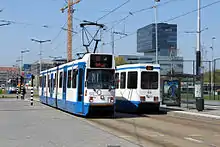 |
Serie 12G built by BN 817-841 all retired by 2 January 2021 |
51/90 | 25.9m / 2.35m | 38 tons | 25 (0) | 1991–2021 |
.jpg.webp) |
Serie 13G Siemens Combino C1: 2001-2130, 2145-2151 C1A: 2131-2144 (with ATB for the Piet Heintunnel) |
55/76 | 29.2m / 2.4m | 36 tons | 151 (151) | 2002–present |
 |
Serie 14G Siemens Combino bidirectional trams C2A: 2201-2204 |
52/99 | 29.2m / 2.4m | 36 tons | 4 (4) | 2002–present |
 |
Serie 15G CAF Urbos 100 bidirectional trams R-net livery: 3001-3025 blue-white livery: 3026-3063 |
50/125 | 30m / 2.4m | 39 tons | 72 (37)[28] | 2020–present |
| Series | Year | Vehicle numbers | Quantity |
|---|---|---|---|
| 11G | 1989 | 901, 903, 906 | 3 |
| 1990 | 902, 904, 905, 907-920 | 17 | |
| 12G | 1990 | 817 | 1 |
| 1991 | 818-841 | 24 | |
| 13G | 2001 | 2001 | 1 |
| 2002 | 2002-2048, 2051-2053 | 50 | |
| 2003 | 2049-2050, 2054-2124 | 73 | |
| 2004 | 2125-2147 | 23 | |
| 2005 | 2148-2151 | 4 | |
| 14G | 2002 | 2201-2204 | 4 |
| 15G | 2019 | 3001, 3003-3006 | 5 |
| 2020 | 3002, 3007-3019, 3022-3035 | 28 | |
| 2021 | 3020, 3036-3038 | 4 |
See also
References
Footnotes
- "Amsterdam Tram". Urban Rail. Retrieved 2020-12-30.
- "Tram - Tram statistics" (in Dutch). GVB. Retrieved 2015-03-10.
- "GVB Holding NV Jaarverslag". Retrieved October 16, 2017.
- "Dubbele trams naar IJburg als proef" (in Dutch). Het Parool. 12 May 2017. Retrieved 30 December 2020.}
- "Nieuwe trams". Amstelveenlijn (in Dutch). City of Amsterdam. Archived from the original on 25 April 2020.}
- "Amstelveen, Oranjebaan". Google Maps. Retrieved 2 January 2021.}
- "Diemen, Diemen Sniep". Google Maps. Retrieved 2 January 2021.}
- Concept vervoerplan bij start Noord/Zuidlijn.pdf, www.gvb.nl; oktober 2016.
- "Vanaf zondag nieuwe dienstregeling GVB: wat verandert er voor u?" (in Dutch). Het Parool. 2013-12-13. Retrieved 2021-01-09.}
- Tram verdwijnt vanaf 2018 deels uit Amsterdams straatbeeld, www.parool.nl; 13 oktober 2016.
- GVB wil Amsterdammers veel vaker in de metro, www.at5.nl; 13 oktober 2016.
- https://www.gvb.nl/
- "Ferdinand Bolstraat afgesloten: tram 16 rijdt om". Het Parool (in Dutch). 8 January 2017. Archived from the original on 8 January 2021. Retrieved 8 January 2021.}
- "Opening IJtramstalling en start gekoppeld rijden op lijn 26". Gemeente Vervoerbedrijf (in Dutch). 29 September 2020. Archived from the original on 22 October 2020. Retrieved 2 January 2021.}
- "151 Combino trams van GVB voorzien van servicebalie". Gemeente Vervoerbedrijf (in Dutch). 26 October 2018. Archived from the original on 11 January 2021. Retrieved 11 January 2021.}
- https://www.amsterdam.nl/parkeren-verkeer/wegwerkzaamheden/wegwerkzaamheden/keerlus-tramlijn-26/
- City of Amsterdam (September 2018). "Amstelveenlijn Factsheet" (pdf). Amstelveenlijn.} Reference PDF file must be downloaded.
- City of Amsterdam (September 2019). "Lijn 25 nieuwe nummer Amsteltram". Amsteltram (in Dutch). Retrieved 14 January 2020.}
- "Meereizen met lijn 25 al mogelijk vanaf woensdag 9 december" (in Dutch). Gemeente Vervoerbedrijf. 9 December 2020. Archived from the original on 8 December 2020. Retrieved 11 December 2020.}
- "Nieuwe tramlijn 6 versterkt lijn 5 in Amstelveen". Gemeente Vervoerbedrijf (in Dutch). 20 May 2019. Archived from the original on 30 June 2019. Retrieved 1 January 2021.}
- "Vernieuwing Amstelveenlijn". Gemeente Vervoerbedrijf (in Dutch). 2 November 2020. Archived from the original on 17 December 2020. Retrieved 18 December 2020.}
- "Vanaf 23 maart nieuwe wijzigingen in onze dienstverlening". Gemeente Vervoerbedrijf (in Dutch). 20 March 2020. Archived from the original on 2 January 2021. Retrieved 2 January 2021.}
- "Dienstregeling 2021 – Veranderingen bij Tram". Gemeente Vervoerbedrijf (in Dutch). 3 January 2021. Archived from the original on 2 January 2021. Retrieved 2 January 2021.}
- "Afsluiting Bullebakbrug in de Marnixstraat". Gemeente Vervoerbedrijf (in Dutch). 19 August 2020. Retrieved 3 January 2021.}
- "Omleiding: Langdurige afsluiting Vijzelstraat". Gemeente Vervoerbedrijf (in Dutch). 6 January 2020. Retrieved 4 January 2021.}
- "IJtramstalling Zeeburgereiland Amsterdam". Qumay Metaal (in Dutch). Archived from the original on 2 January 2021. Retrieved 2 January 2021.}
- "Afbouw opstelterrein en werkzaamheden". Amstelveenlijn (in Dutch). City of Amsterdam. 16 January 2020. Archived from the original on 25 April 2020. Retrieved 17 January 2020.}
- "Nieuwe 15G trams". Gemeente Vervoerbedrijf (in Dutch). 29 December 2020. Retrieved 2 January 2021.}
Bibliography
- Duparc, H J A (1990). Lijnenloop Openbaar Vervoer Amsterdam 1839-1989 [Loopline public transport Amsterdam 1839-1989] (in Dutch). Amsterdam: Gemeentevervoerbedrijf. ISBN 90-901395-7-5.
- Duparc, H J A (2000). Een Eeuw Elektrische Exploitatie van de tram in Amsterdam [A Century of Electric Operation of Trams in Amsterdam] (in Dutch). Delft: H J A Duparc. ISBN 90-901395-7-5.
- Freeke, Jan (1990). De kunst van het vervoer. Een beeld van 150 jaar Amsterdams openbaar vervoer [The art of transport. A picture of 150 years of public transport in Amsterdam.] (in Dutch). Den Haag: SDU Uitgeverij. ISBN 90-12-06442-2.
- van ‘t Hoogerhuijs, Herman (1996). Trammaterieel in Nederland en België [Tram Equipment in the Netherlands and Belgium] (in Dutch). Alkmaar: De Alk. ISBN 90-6013-948-8.
- Leideritz, W J M (1979). Van Paardentram naar Dubbelgelede [From Horse Tram to Double Articulated] (in Dutch). Alkmaar: De Alk. ISBN 90-6013-904-6.
- Stoer, Gerard (1982). Spoor en tram materieel in Nederland [Rail and tram equipment in the Netherlands] (in Dutch). Alkmaar: De Alk. ISBN 90-6013-916-X.
- Visser, Noëlle (2000). In grote lijnen: het Amsterdamse openbaar vervoer (1900-2000), ter gelegenheid van het 100-jarig bestaan van het GVB [In grote lijnen: Public Transport in Amsterdam (1900-2000), to mark the 100th anniversary of the GVB] (in Dutch). Amsterdam: Gemeentevervoerbedrijf.
External links
| Wikimedia Commons has media related to Trams in Amsterdam. |
- Geheugen van de Amsterdamse Tram (Memories of Amsterdam trams) (in Dutch) – with many images.
- Photos of the Amsterdam tram in the Image Bank, Amsterdam of the Stadsarchief Amsterdam (Amsterdam City Archives) (in Dutch)
- Amsterdam database / photo gallery and Amsterdam tram list at Urban Electric Transit – in various languages, including English.
- Amsterdam database / photo gallery at Phototrans – in various languages, including English.
- Amsterdam photo gallery at public-transport.net

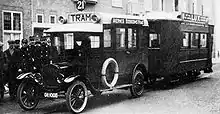

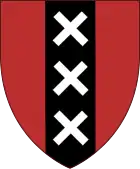
.jpg.webp)